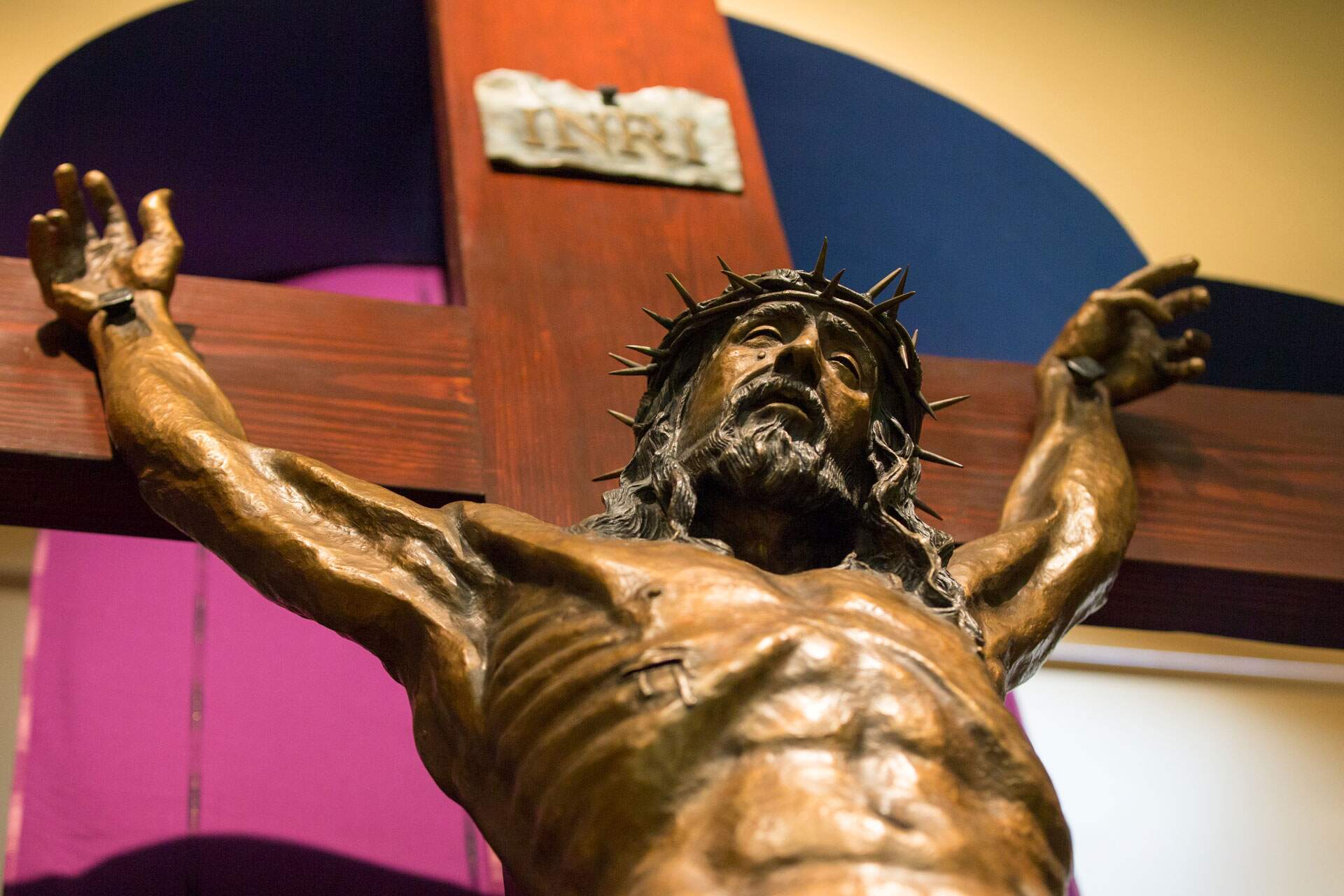A. Preliminary remarks
- A criticism of the New Rite cannot be a criticism of the Mass in itself, for this is the very sacrifice of Our Lord bequeathed to His Church, but it is an examination, whether it is a fit rite for embodying and enacting this august Sacrifice.
- It is difficult for those who have known nothing other than the Novus Ordo Missae to understand of what they have been deprived, and attending a “Latin Mass” often just seems alien. To see clearly what it is all about, it is necessary to have a clear understanding of the defined truths of our Faith on the Mass (principles 11-18 are some of them). Only in the light of these can the “new rite” of Mass be evaluated.
B. What is the Novus Ordo Missae?
Let us answer this by looking at its four causes, as the philosophers would say:
What are the elements that make up the New Rite? Some are Catholic:
- a priest,
- bread and wine,
- genuflections,
- signs of the Cross, etc.,
but some are Protestant:
- a table,
- common-place utensils,
- communion under both kinds and in the hand, etc.
Now, the Novus Ordo Missae assumes these heterodox elements alongside the Catholic ones to form a liturgy for a modernist religion which would marry the Church and the world, Catholicism and Protestantism, light and darkness. Indeed, the Novus Ordo Missae presents itself as:
- a meal (vs. principle 11). This is shown by its use of a table around which the people of God gather to offer bread and wine (vs. principle 18) and to communicate from rather common-place utensils, often under both kinds (vs. principle 15), and usually in the hand (vs. principle 16). (Note too the almost complete deletion of references to sacrifice).
- a narrative of a past event (vs. principle 12). This told out loud by the one presiding (vs. principle 14), who recounts Our Lord’s words as read in Scripture (rather than pronouncing a sacramental formula) and who makes no pause until he has shown the Host to the people.
- a community gathering, (vs. principle 13). Christ is perhaps considered to be morally present but ignored in his Sacramental Presence (vs. principles 16 & 17).
Notice also the numerous rubrical changes:
- the celebrant facing the people from where the tabernacle was formerly kept.
- just after the consecration, all acclaim He “will come again.“
- sacred vessels are no longer gilt.
- Sacred Particles are ignored (vs. principle 15)
- the priest no longer joins thumb and forefinger after the consecration.
- the vessels are not purified as they used to be.
- Communion is most frequently given in the hand.
- genuflections on the part of the priest and kneeling on the part of the faithful are much reduced.
- the people take over much of what the priest formerly did.
Moreover, the Novus Ordo Missae defined itself this way:
The Lord’s Supper, or Mass, is a sacred synaxis, or assembly of the people of God gathered together under the presidency of the priest to celebrate the memorial of the Lord. (Pope Paul VI, Institutio Generalis, §7, 1969 version)
What is the aim of the Novus Ordo Missae as a rite?
…the intention of Pope Paul VI with regard to what is commonly called the Mass, was to reform the Catholic liturgy in such a way that it should almost coincide with the Protestant liturgy… there was with Pope Paul VI an ecumenical intention to remove, or at least to correct, or at least to relax, what was too Catholic, in the traditional sense, in the Mass and, I repeat, to get the Catholic Mass closer to the Calvinist mass…*⤸
*Jean Guitton on December 19, 1993 in Apropos (17), p. 8ff [also in Christian Order, October 1994]. Jean Guitton was an intimate friend of Pope Paul VI. Paul VI had 116 of his books and had made marginal study notes in 17 of these:
When I began work on this trilogy I was concerned at the extent to which the Catholic liturgy was being Protestantized. The more detailed my study of the Revolution, the more evident it has become that it has by-passed Protestantism and its final goal is humanism. (Pope Paul’s New Mass, pp. 137 and 149)
This latter is a fair evaluation when one considers the changes implemented, the results achieved, and the tendency of modern theology, even papal theology (cf. question 7).
- WHO made up the Novus Ordo Missae?
It is the invention of a liturgical commission, the Consilium, whose guiding light was Fr. Annibale Bugnini (made an archbishop in 1972 for his services), and which also included six Protestant experts. Fr. Bugnini (principal author of Vatican II’s Sacrosanctum Concilium) had his own ideas on popular involvement in the liturgy (La Riforma Liturgia, A. Bugnini, Centro Liturgico Vincenziano, 1983), while the Protestant advisors had their own heretical ideas on the essence of the Mass.
But the one on whose authority the Novus Ordo Missae was enforced was Pope Paul VI, who “promulgated” it by his apostolic constitution, Missale Romanum (April 3, 1969).
- Or did Pope Paul VI REALLY DO SO?
In the original version of Missale Romanum, signed by Pope Paul VI, no mention was made either of anyone’s being obliged to use the Novus Ordo Missae or when such an obligation might begin.
Translators of the constitution mistranslated cogere et efficere (i.e., to sum up and draw a conclusion) as to give force of law.
The version in the Acta Apostolicae Sedis (which records all official texts of the papacy) has an added paragraph “enjoining” the new missal, but it is in the wrong tense, the past, and reads praescripsimus (i.e., which we have ordered) thereby referring to a past obligation, and nothing, moreover, in Missale Romanum prescribes, but at most permits the use of the “New Rite” (The Angelus, March 1997, p. 35).
Can it be true that Pope Paul VI wanted this missal but that it was not properly imposed (it is known moreover, that Pope Paul VI signed the Institutio Generalis without reading it and without ensuring that it had been previously confirmed by the Holy Office).
C. Judgment on the Novus Ordo Missae
Judging the Novus Ordo Missae in itself and in its official Latin form (printed in 1969)*⤸, Cardinals Ottaviani and Bacci wrote to Pope Paul VI:
…the Novus Ordo represents, both as a whole and in its details, a striking departure from the Catholic theology of the Mass as it was formulated in Session XXIII of the Council of Trent.
(A Brief Critical Study of the Novus Ordo Missae, September 25, 1969)
*A Novus Ordo Missae celebrated according to the 1969 typical edition would look very similar to the traditional Roman Rite, with the celebrant saying most (if not all) the prayers in Latin, facing the tabernacle and wearing the traditional Mass vestments, with a male altar server, and Gregorian chant, etc. None of the current abuses, e.g., Communion in the hand, Eucharistic Ministers, liturgical dancing, guitar-masses, etc., have part with this official form. Hence, the aforementioned cardinals’ (as well as the SSPX’s) critique of the Novus Ordo Missae is not of its abuses or misapplication, but rather of its essential and official form.
And Archbishop Lefebvre definitely agreed with them when he wrote:
The Novus Ordo Missae, even when said with piety and respect for the liturgical rules, …is impregnated with the spirit of Protestantism. It bears within it a poison harmful to the faith
(An Open Letter to Confused Catholics, p. 29 [appendix 2])
The dissimulation of Catholic elements and the pandering to Protestants which are evident in the Novus Ordo Missae render it a danger to our faith, and, as such, evil, given that it lacks the good which the sacred rite of Mass ought to have.
By their fruits you shall know them:
We were promised the Novus Ordo Missae would renew Catholic fervor, inspire the young, draw back the lapsed and attract non-Catholics.
Who today can pretend that these things are its fruits? Together with the Novus Ordo Missae did there not instead come a dramatic decline in Mass attendance and vocations, an “identity crisis” among priests, a slowing in the rate of conversions, and an acceleration of apostasies? So, from the point of view of its fruits, the Novus Ordo Missae is not a rite conducive to the flourishing of the Church’s mission.
Does it follow from the apparent promulgation by the popes that the Novus Ordo Missae is truly Catholic?
No, for the indefectibility of the Church does not prevent the pope personally from promoting defective and modernist rites in the Latin rite of the Church. Moreover, the Novus Ordo Missae:
- was not properly promulgated (and therefore does not have force of law; cf., [vi] above),
- the old Roman Mass (aka, the Tridentine or traditional Latin Mass) was not abolished or superseded in the constitution Missale Romanum, hence in virtue of the of Quo Primum (which de jure [by law] is still the liturgical law and therefore the official Mass of the Roman Rite), it can always be said (principle 19),
- and lastly, the constitution Missale Romanum does not engage the Church’s infallibility.*⤸
*Let us remember that a pope engages his infallibility not only when teaching on faith or morals (or legislating on what is necessarily connected with them) but when so doing with full pontifical authority and definitively (cf. Vatican I [Dz 1839]. But as regards the Novus Ordo Missae, Pope Paul VI has stated (November 19, 1969) that:
…the rite and its related rubric are not in themselves a dogmatic definition. They are capable of various theological qualifications, depending on the liturgical context to which they relate. They are gestures and terms relating to a lived and living religious action which involves the ineffable mystery of God’s presence; it is an action that is not always carried out in the exact same form, an action that only theological analysis can examine and express in doctrinal formulas that are logically satisfying.
NB: It should be also be understood that the papal bull, Quo Primum is neither an infallible document, but rather only a disciplinary document regarding the liturgical law that governs the Tridentine Rite (cf. this Catholic FAQ for details).
D. This being so, can it be said that the Novus Ordo Missae is invalid?
This does not necessarily follow from the above defects, as serious as they might be, for only three things are required for validity (presupposing a validly ordained priest), proper:
- matter,
- form,
- and intention.
However, the celebrant must intend to do what the Church does. The Novus Ordo Missae will no longer in and of itself guarantee that the celebrant has this intention. That will depend on his personal faith (generally unknown to those assisting, but more and more doubtful as the crisis in the Church is prolonged).
Therefore, these Masses can be of doubtful validity, and more so with time.
The words of consecration, especially of the wine, have been tampered with. Has the “substance of the sacramentI (cf., Pope Pius XII quoted in principle 5) been respected? This is even more of a problem in Masses in the vernacular, where pro multis (for many) has been deliberately mistranslated as “for all”. While we should assume that despite this change the consecration is still valid, nevertheless this does add to the doubt.
E. Considering what has been said, are we obliged in conscience to attend the Novus Ordo Missae?
If the Novus Ordo Missae is not truly Catholic, then it cannot oblige for one’s Sunday obligation. Many Catholics who do assist at it are unaware of its all pervasive degree of serious innovation and are exempt from guilt. However, any Catholic who is aware of its harm, does not have the right to participate. He could only then assist at it by a mere physical presence without positively taking part in it, and then and for major family reasons (weddings, funerals, etc).



